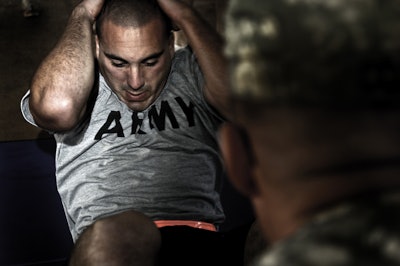Article sponsored by:
Army leaders are in the midst of a multi-year, comprehensive physical readiness study to discover, define and implement the best physical fitness solutions for soldiers. While still in its early stages, the process will potentially impact the facilities and experts responsible for ensuring soldier physical readiness.Mike Haith, HQE (highly qualified expert) for human dimension integration at the Army Initial Military Training Center of Excellence, Fort Eustis, Va., says the Baseline Soldier Physical Readiness Study emerged in 2012 after the Army pilot-tested the five-event Army Physical Readiness Test (APRT) and determined it was an inadequate fitness tool for commanders. (The test eliminated sit-ups but included a 60-yard shuttle run, one-minute rowing test, standing long jump, one-minute pushup test and 1.5-mile run.)
 APFT 1.jpg
APFT 1.jpg
"The chief of staff of the Army decided we're not going to deploy this test," Haith says. "We're going to conduct a more comprehensive review to develop an assessment tool that's gender-neutral, and it may in some ways be age-neutral, because the task is the task."The study addresses what it calls the two levels of baseline soldier physical readiness: general physical fitness and functional fitness.
According to information provided by the Center of Excellence, "general fitness" is the condition where "soldiers possess the capacity (strength, endurance and mobility) to execute WTBD [Warrior Tasks and Battle Drills]," and "functional fitness" is where they "possess the ability to perform WTBD" by integrating strength, endurance and mobility.
"What we've learned specifically is the previous training programs and the test was not adequate to prepare or assess soldiers' physical ability to perform in theater," Haith says.
"What we have to do is get away from the belief that we can do all of this without any equipment," Haith says. "We believe the Army needs to invest in the facilities necessary to train safely and effectively."
This means facilities that prepare soldiers to perform military tasks.
"If we don't have the facilities to adequately prepare them, then soldiers are going to do what they've always done: They're just going to look at the exercise event and just do the event every day in the hopes that that will improve performance," Haith says.
The Baseline Soldier Physical Readiness Study is in the first phase of a five-phase process set to conclude in April 2015 with a presentation and recommendations to Army leadership. The initial phase involves performing a comprehensive review of literature, case studies and fitness performance tasks from a variety of sectors, including military forces in other countries, police and even fire departments.
Outside influences and current actions will still impact the process.
The return of the Army's Master Fitness Training (MFT) course is one of those influences. Discontinued in 2001, the course certifies Master Fitness Trainers who then become advisers to unit commanders and ensure troop fitness. After a pilot program in late 2012 re-established the effort, a course earlier this year trained six mobile training teams. Beginning in April, those teams will travel to Army installations worldwide and prepare more new trainers. The Army's goal is 4,500 certified trainers at bases and facilities around the globe by the end of 2014.
Haith calls the MFT process the "opposite side of the same coin."
"What we're learning and have learned about physical development and how you train properly is integrated into the Master Fitness Training course," he says. "We need leaders out there advising commanders on how to [develop a program.]"
Other influences impact the process as well. In January, for example, the Defense Department rescinded the policy that had excluded women in direct combat positions since 1994. Haith says that has impacted what the Army is doing, but officials were already on their current path even before the lift on the women-in-combat ban was announced, as the study's entire approach is gender-neutral and focused on requirements to meet tasks. But the Army is addressing comparative performance between men and women.
"Strip out this emotional stuff and just get at what we know about women's capabilities and men's capabilities," Haith says. "How do they compare?"
The study also will investigate how current training programs influence injuries.
"In the next month or two, we're going to complete our systematic review," Haith says. "And we hope to present to senior Army leaders what we found in the areas of human performance."




































